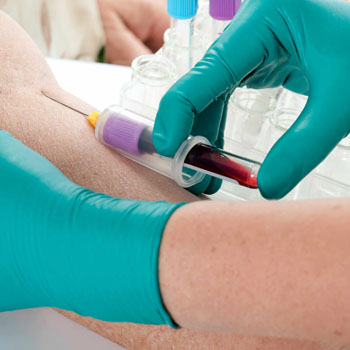Overtesting for Diabetes Tends to Reap Negative “Rewards”
|
By LabMedica International staff writers Posted on 23 Dec 2015 |

Caption: A new study has shown that there is a US national trend toward overtesting in adult patients with Type 2 diabetes and that excessive testing increased the odds of overtreatment with one or more drugs (Image courtesy of Mayo Clinic).
Researchers report a US national trend toward overtesting of glycated hemoglobin (HbA1c) levels in adult patients with Type 2 diabetes, leading to unnecessary cost, time, and other burdens for patients and providers, as well as potential patient health complications due to overtreatment with hypoglycemic drugs.
A new study led by Mayo Clinic (Rochester, MN, USA) researchers has shown that patients with Type 2 diabetes are often tested much more frequently than clinically indicated. Type 2 diabetes monitoring and treatment protocols are not well defined by professional societies and regulatory bodies. While lower thresholds of testing frequencies are often discussed, the upper boundaries are rarely mentioned. Yet, most agree that checking 1–2 times/year should suffice for adult patients who are not using insulin, have stable glycemic control within the recommended targets, and have no history of severe hypoglycemia or hyperglycemia. Yet, in practice, there is a much higher prevalence of excessive testing.
Upon examining a national cohort of 31,545 non-pregnant adults with controlled non-insulin-treated Type 2 diabetes, the investigators said the study provides definitive evidence of such excess testing. The patient cohort examined was derived from the OptumLabs Data Warehouse (OLDW) using de-identified administrative, pharmacy, and laboratory data from 2001 to 2011. Approximately 55% achieved and maintained the recommended less than 7% HbA1c level and were tested 3–4 times/year; 6% were tested 5 or more times.
“Our findings are concerning, especially as we focus more on improving the value of care we deliver to our patients—not only ensuring maximal benefit, but also being mindful of waste, patient burden, and healthcare costs,” said study lead investigator Rozalina McCoy, MD, Mayo Clinic, “As providers, we must be ever vigilant.”
“Potential reasons for more frequent testing include clinical uncertainty; misunderstanding of the nature of the test—that is, not realizing that HbA1c represents a 3-month average of glycemic control; or a desire for diagnostic and management thoroughness,” said Dr. McCoy, “Other times, it may be the result of fragmentation of care (more than one unconnected provider); the need to fulfill regulatory demands, such as public reporting of performance metrics; or internal tracking of performance. “Because our culture often thinks that more is better” patients and providers may favor additional testing due to a desire for comprehensive care, she added.
The researchers also found that excessive testing increased the odds of overtreatment with one or more drugs, despite normal HbA1c levels, and that rates of overtesting were lower among patients receiving bundled testing (i.e., cholesterol, creatinine, and HbA1c tests in the same day).
“We hope that these findings will help inform decision-making,” said Dr. McCoy.
The study was published December 8, 2015, in the British Journal of Medicine.
Related Links:
Mayo Clinic
Mayo Clinic Robert D. and Patricia E. Kern Center for the Science of Health Care Delivery
OptumLabs
A new study led by Mayo Clinic (Rochester, MN, USA) researchers has shown that patients with Type 2 diabetes are often tested much more frequently than clinically indicated. Type 2 diabetes monitoring and treatment protocols are not well defined by professional societies and regulatory bodies. While lower thresholds of testing frequencies are often discussed, the upper boundaries are rarely mentioned. Yet, most agree that checking 1–2 times/year should suffice for adult patients who are not using insulin, have stable glycemic control within the recommended targets, and have no history of severe hypoglycemia or hyperglycemia. Yet, in practice, there is a much higher prevalence of excessive testing.
Upon examining a national cohort of 31,545 non-pregnant adults with controlled non-insulin-treated Type 2 diabetes, the investigators said the study provides definitive evidence of such excess testing. The patient cohort examined was derived from the OptumLabs Data Warehouse (OLDW) using de-identified administrative, pharmacy, and laboratory data from 2001 to 2011. Approximately 55% achieved and maintained the recommended less than 7% HbA1c level and were tested 3–4 times/year; 6% were tested 5 or more times.
“Our findings are concerning, especially as we focus more on improving the value of care we deliver to our patients—not only ensuring maximal benefit, but also being mindful of waste, patient burden, and healthcare costs,” said study lead investigator Rozalina McCoy, MD, Mayo Clinic, “As providers, we must be ever vigilant.”
“Potential reasons for more frequent testing include clinical uncertainty; misunderstanding of the nature of the test—that is, not realizing that HbA1c represents a 3-month average of glycemic control; or a desire for diagnostic and management thoroughness,” said Dr. McCoy, “Other times, it may be the result of fragmentation of care (more than one unconnected provider); the need to fulfill regulatory demands, such as public reporting of performance metrics; or internal tracking of performance. “Because our culture often thinks that more is better” patients and providers may favor additional testing due to a desire for comprehensive care, she added.
The researchers also found that excessive testing increased the odds of overtreatment with one or more drugs, despite normal HbA1c levels, and that rates of overtesting were lower among patients receiving bundled testing (i.e., cholesterol, creatinine, and HbA1c tests in the same day).
“We hope that these findings will help inform decision-making,” said Dr. McCoy.
The study was published December 8, 2015, in the British Journal of Medicine.
Related Links:
Mayo Clinic
Mayo Clinic Robert D. and Patricia E. Kern Center for the Science of Health Care Delivery
OptumLabs
Latest Clinical Chem. News
- Chemical Imaging Probe Could Track and Treat Prostate Cancer
- Mismatch Between Two Common Kidney Function Tests Indicates Serious Health Problems
- VOCs Show Promise for Early Multi-Cancer Detection
- Portable Raman Spectroscopy Offers Cost-Effective Kidney Disease Diagnosis at POC
- Gold Nanoparticles to Improve Accuracy of Ovarian Cancer Diagnosis
- Simultaneous Cell Isolation Technology Improves Cancer Diagnostic Accuracy
- Simple Non-Invasive Hair-Based Test Could Speed ALS Diagnosis
- Paper Strip Saliva Test Detects Elevated Uric Acid Levels Without Blood Draws
- Prostate Cancer Markers Based on Chemical Make-Up of Calcifications to Speed Up Detection
- Breath Test Could Help Detect Blood Cancers
- ML-Powered Gas Sensors to Detect Pathogens and AMR at POC
- Saliva-Based Cancer Detection Technology Eliminates Need for Complex Sample Preparation
- Skin Swabs Could Detect Parkinson’s Years Before Symptoms Appear
- New Clinical Chemistry Analyzer Designed to Meet Growing Demands of Modern Labs

- New Reference Measurement Procedure Standardizes Nucleic Acid Amplification Test Results
- Pen-Like Tool Quickly and Non-Invasively Detects Opioids from Skin
Channels
Molecular Diagnostics
view channel
Simple Urine Test to Revolutionize Bladder Cancer Diagnosis and Treatment
Bladder cancer is one of the most common and deadly urological cancers and is marked by a high rate of recurrence. Diagnosis and follow-up still rely heavily on invasive cystoscopy or urine cytology, which... Read more
Blood Test to Enable Earlier and Simpler Detection of Liver Fibrosis
Persistent liver damage caused by alcohol misuse or viral infections can trigger liver fibrosis, a condition in which healthy tissue is gradually replaced by collagen fibers. Even after successful treatment... Read moreHematology
view channel
Platelet Activity Blood Test in Middle Age Could Identify Early Alzheimer’s Risk
Early detection of Alzheimer’s disease remains one of the biggest unmet needs in neurology, particularly because the biological changes underlying the disorder begin decades before memory symptoms appear.... Read more
Microvesicles Measurement Could Detect Vascular Injury in Sickle Cell Disease Patients
Assessing disease severity in sickle cell disease (SCD) remains challenging, especially when trying to predict hemolysis, vascular injury, and risk of complications such as vaso-occlusive crises.... Read more
ADLM’s New Coagulation Testing Guidance to Improve Care for Patients on Blood Thinners
Direct oral anticoagulants (DOACs) are one of the most common types of blood thinners. Patients take them to prevent a host of complications that could arise from blood clotting, including stroke, deep... Read moreImmunology
view channel
New Test Distinguishes Vaccine-Induced False Positives from Active HIV Infection
Since HIV was identified in 1983, more than 91 million people have contracted the virus, and over 44 million have died from related causes. Today, nearly 40 million individuals worldwide live with HIV-1,... Read more
Gene Signature Test Predicts Response to Key Breast Cancer Treatment
DK4/6 inhibitors paired with hormone therapy have become a cornerstone treatment for advanced HR+/HER2– breast cancer, slowing tumor growth by blocking key proteins that drive cell division.... Read more
Chip Captures Cancer Cells from Blood to Help Select Right Breast Cancer Treatment
Ductal carcinoma in situ (DCIS) accounts for about a quarter of all breast cancer cases and generally carries a good prognosis. This non-invasive form of the disease may or may not become life-threatening.... Read moreMicrobiology
view channel
Rapid Diagnostic Test Matches Gold Standard for Sepsis Detection
Sepsis kills 11 million people worldwide every year and generates massive healthcare costs. In the USA and Europe alone, sepsis accounts for USD 100 billion in annual hospitalization expenses.... Read moreRapid POC Tuberculosis Test Provides Results Within 15 Minutes
Tuberculosis remains one of the world’s deadliest infectious diseases, and reducing new cases depends on identifying individuals with latent infection before it progresses. Current diagnostic tools often... Read more
Rapid Assay Identifies Bloodstream Infection Pathogens Directly from Patient Samples
Bloodstream infections in sepsis progress quickly and demand rapid, precise diagnosis. Current blood-culture methods often take one to five days to identify the pathogen, leaving clinicians to treat blindly... Read morePathology
view channel
Tunable Cell-Sorting Device Holds Potential for Multiple Biomedical Applications
Isolating rare cancer cells from blood is essential for diagnosing metastasis and guiding treatment decisions, but remains technically challenging. Many existing techniques struggle to balance accuracy,... Read moreAI Tool Outperforms Doctors in Spotting Blood Cell Abnormalities
Diagnosing blood disorders depends on recognizing subtle abnormalities in cell size, shape, and structure, yet this process is slow, subjective, and requires years of expert training. Even specialists... Read moreTechnology
view channel
Artificial Intelligence Model Could Accelerate Rare Disease Diagnosis
Identifying which genetic variants actually cause disease remains one of the biggest challenges in genomic medicine. Each person carries tens of thousands of DNA changes, yet only a few meaningfully alter... Read more
AI Saliva Sensor Enables Early Detection of Head and Neck Cancer
Early detection of head and neck cancer remains difficult because the disease produces few or no symptoms in its earliest stages, and lesions often lie deep within the head or neck, where biopsy or endoscopy... Read moreIndustry
view channel
Abbott Acquires Cancer-Screening Company Exact Sciences
Abbott (Abbott Park, IL, USA) has entered into a definitive agreement to acquire Exact Sciences (Madison, WI, USA), enabling it to enter and lead in fast-growing cancer diagnostics segments.... Read more






















